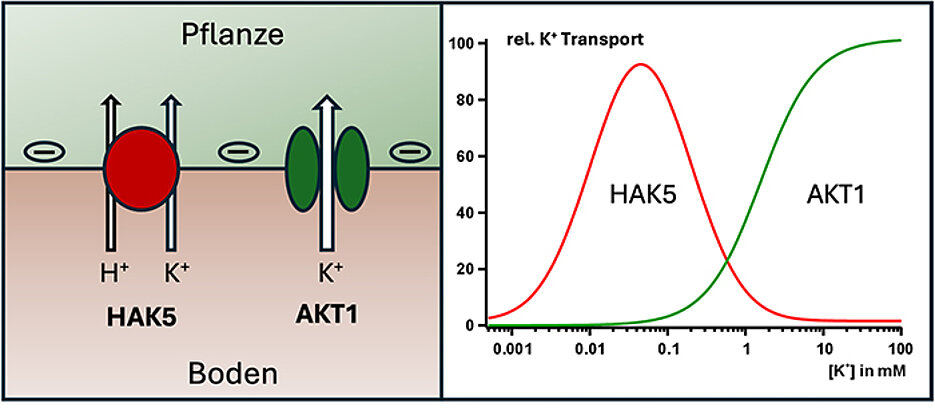Plants Save Energy when Absorbing Potassium
10/09/2024Plants can extract even the smallest traces of the important nutrient potassium from the soil. A team led by Würzburg biophysicist Rainer Hedrich describes how they achieve this in ‘Nature Communications’.

Potassium is one of the nutrients that plants need in large quantities. However, the amount of potassium in the soil can vary greatly: potassium-poor soils can contain up to a thousand times less of this nutrient than potassium-rich soils. To be able to react flexibly to these differences, plants have developed mechanisms with which they adapt their potassium uptake to the respective soil condition.
Like the cells of the human body, plant cells also work with an operating potassium concentration of around 100 millimolar. If the roots find a potassium source with a significantly lower concentration or only traces of it, they can only absorb the potassium into their cells by expending energy. This is achieved by the interaction between the potassium ion channel AKT1 and the potassium transporter HAK5.
Research is Relevant for Plant Breeding
‘Although HAK5 has been known since the late 1990s, its transport mechanism has so far remained largely unknown,’ says Professor Rainer Hedrich from Julius-Maximilians-Universität (JMU) Würzburg in Bavaria, Germany. A team led by the Würzburg biophysicist now wanted to elucidate this mechanism: ‘Knowledge about this is important when it comes to breeding crops that also produce yields on non-fertilised or only lightly fertilised fields, i.e. that can manage with less fertiliser.’
In their experiments, the Würzburg research group led by first authors Tobias Maierhofer and Sönke Scherzer benefited from their extensive experience with the potassium channel AKT1. The group now describes their results in detail in the journal Nature Communications.
Establishing a pH Gradient Costs Energy
For the AKT1 channel to transport potassium into the cells, higher soil potassium concentrations are required. The normal electric field of the cell membrane is sufficient as an energy source. The HAK5 transporter, on the other hand, already works at low soil potassium levels. In addition to the electric field, it needs the energy of the pH gradient. The plant must build up this gradient across the cell membranes, and this costs energy.
Further experiments showed that the potassium transporter HAK5 and the potassium channel AKT1 co-operate in an energy-saving manner when the potassium concentration in the soil fluctuates.
Transporter Must Have a Potassium Sensor
At high concentrations, the energy-guzzling transporter HAK5 is switched off. This means that the transporter must have a potassium sensor. In their search for the sensor, the Frankfurt structural biologist Inga Hänelt and her Würzburg colleague Thomas Müller made progress: they found a mutant of the transporter in which the affinity for potassium is 100 times lower.
‘Now it is important to explore in more detail the molecular reactions that trigger the mutation,’ says Rainer Hedrich, describing the next research goals. He also wants to find out how potassium transport into the root cell is mechanically and energetically coupled to proton transport.
Publication
Arabidopsis HAK5 under low K+ availability operates as PMF powered high-affinity K+. Tobias Maierhofer, Sönke Scherzer, Armando Carpaneto, Thomas D. Müller, Jose M. Pardo, Inga Hänelt, Dietmar Geiger & Rainer Hedrich, Nature Communications, 3 October 2024, Open Access: https://www.nature.com/articles/s41467-024-52963-6
Contact
Prof. Dr Rainer Hedrich, Chair of Botany I (Molecular Plant Physiology and Biophysics), University of Würzburg, T +49 931 31-86100, hedrich@botanik.uni-wuerzburg.de






